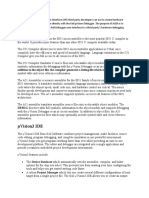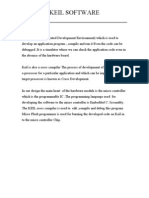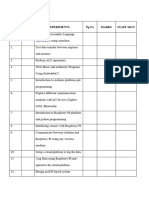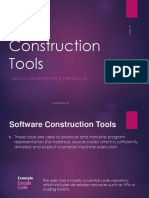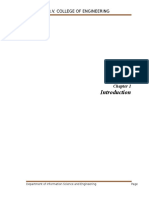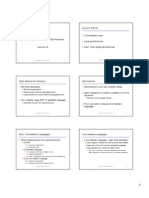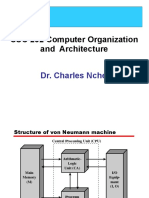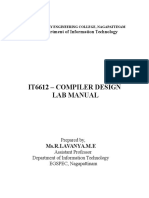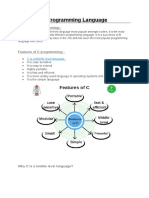Keil IDE
Keil IDE
Uploaded by
Ankit AgrawalCopyright:
Available Formats
Keil IDE
Keil IDE
Uploaded by
Ankit AgrawalOriginal Description:
Copyright
Available Formats
Share this document
Did you find this document useful?
Is this content inappropriate?
Copyright:
Available Formats
Keil IDE
Keil IDE
Uploaded by
Ankit AgrawalCopyright:
Available Formats
What is an Assembler?
An assembler is a program that translates symbolic code (assembly language) into executable object code. This object code can be executed with a 80C51-compatible microcontroller. If you have ever written a computer program directly in machine-recognizable form, such as binary or hexadecimal code, you will appreciate the advantages of programming in symbolic assembly language. Assembly language operation codes (mnemonics) are easily remembered (MOV for move instructions, ADD for addition, and so on). You can also symbolically express addresses and values referenced in the operand field of instructions. Because you assign these names, you can make them as meaningful as the mnemonics for the instructions. For example, if your program must manipulate a date as data, you can assign it the symbolic name DATE. If your program contains a set of instructions used as a timing loop (executed repeatedly until a specific amount of time has passed), you can name the instruction group TIMER_LOOP. An assembly program has three parts:
Machine instructions - Code the machine can execute. Detailed discussion of the machine instructions is in the hardware manuals of the 80C51 microcontroller. Assembler directives - Define the program structure and symbols, and generate non executable code (data, messages, and so on.). Assembler controls - Set assembly modes and direct assembly flow.
Vision3 Overview
The Vision3 IDE is a Windows-based software development platform that combines a robust editor, project manager, and make facility. Vision3 integrates all tools including the C compiler, macro assembler, linker/locator, and HEX file generator. Vision3 helps expedite the development process of your embedded applications by providing the following:
Full-featured source code editor, Device database for configuring the development tool setting, Project manager for creating and maintaining your projects, Integrated make facility for assembling, compiling, and linking your embedded applications, Dialogs for all development tool settings, True integrated source-level Debugger with high-speed CPU and peripheral simulator, Advanced GDI interface for software debugging in the target hardware and for connection to Keil ULINK, Flash programming utility for downloading the application program into Flash ROM, Links to development tools manuals, device datasheets & users guides.
The Vision3 IDE offers numerous features and advantages that help you quickly and successfully develop embedded applications. They are easy to use and are guaranteed to help you achieve your design goals. The Vision3 IDE and Debugger is the central part of the Keil development toolchain. Vision3 offers a Build Mode and a Debug Mode. In the Vision3 Build Mode you maintain the project files and generate the application. In the Vision3 Debug Mode you verify your program either with a powerful CPU and peripheral simulator or with the Keil ULINK USB-JTAG Adapter (or other AGDI drivers) that connect the debugger to the target system. The ULINK allows you also to download your application into Flash ROM of your target system.
Features and Benefits
Feature The Vision3 Simulator is the only debugger that completely simulates all on-chip peripherals. Simulation capabilities may be expanded using the Advanced Simulation Interface (AGSI). The Code Coverage feature of the Vision3 Simulator provides statistical analysis of your programs execution. The Vision3 Device Database automatically configures the development tools for the target microcontroller. Benefit Write and test application code before production hardware is available. Investigate different hardware configurations to optimize the hardware design. Sophisticated systems can be accurately simulated by adding your own peripheral drivers.
Safety-critical systems can be thoroughly tested and validated. Execution analysis reports can be viewed and printed for certification requirements. Mistakes in tool settings are practically eliminated and tool configuration time is minimized.
The Vision3 IDE integrates additional third- Quickly access development tools and third-party tools. party tools like VCS, CASE, and All configuration details are saved in the Vision3 project. FLASH/Device Programming. The ULINK USB-JTAG Adapter supports both Debugging and Flash programming with configurable algorithm files. Identical Target Debugger and Simulator User Interface. Vision3 incorporates project manager, editor, and debugger in a single environment. The same tool can be used for debugging and programming. No extra configuration time required.
Shortens your learning curve.
Accelerates application development. While editing, you may configure debugger features. While debugging, you may make source code modifications.
About the Environment
The Vision3 screen provides you with a menu bar for command entry, a tool bar where you can rapidly select command buttons, and windows for source files, dialog boxes, and information displays. Vision3 lets you simultaneously open and view multiple source files. Vision3 has two operating modes:
Build Mode: Allows you to translate all the application files and to generate executable programs. The features of the Build Mode are described under Creating Applications. Debug Mode: Provides you with a powerful debugger for testing your application. The Debug Mode is described in Testing Programs.
In both operating modes you may use the source editor of Vision3 to modify your source code. The Debug mode adds additional windows and stores an own screen layout. The following picture shows a typical configuration of Vision3 in the Debug Mode.
Software Development Cycle
When you use the Keil Vision, the project development cycle is roughly the same as it is for any other software development project. 1. 2. Create a project, select the target chip from the device database, and configure the tool settings. Create source files in C or assembly.
3. 4. 5.
Build your application with the project manager. Correct errors in source files. Test the linked application.
The following block diagram illustrates the complete Vision/ARM software development cycle. Each component is described below.
Vision IDE
The Vision IDE combines project management, a rich-featured editor with interactive error correction, option setup, make facility, and on-line help. Use Vision to create your source files and organize them into a project that defines your target application. Vision automatically compiles, assembles, and links your embedded application and provides a single focal point for your development efforts.
C51 Compiler & A51 Macro Assembler
Source files are created by the Vision IDE and are passed to the C51 Compiler or A51 Macro Assembler. The compiler and assembler process source files and create relocatable object files. The Keil C51 Compiler is a full ANSI implementation of the C programming language that supports all standard features of the C language. In addition, numerous features for direct support of the 8051 architecture have been added. The Keil A51 macro assembler supports the complete instruction set of the 8051 and all derivatives.
LIB51 Library Manager
The LIB51 library manager allows you to create object library from the object files created by the compiler and assembler. Libraries are specially formatted, ordered program collections of object modules that may be used by the linker at a later time. When the linker processes a library, only those object modules in the library that are necessary to create the program are used.
BL51 Linker/Locator
The BL51 Linker/Locator creates an absolute ELF/DWARF file using the object modules extracted from libraries and those created by the compiler and assembler. An absolute object file or module contains no relocatable code or data. All code and data reside at fixed memory locations. The absolute ELF/DWARF file may be used:
To program an Flash ROM or other memory devices, With the Vision Debugger for simulation and target debugging, With an in-circuit emulator for the program testing.
Vision Debugger
The Vision symbolic, source-level debugger is ideally suited for fast, reliable program debugging. The debugger includes a high-speed simulator that let you simulate an entire 8051 system including onchip peripherals and external hardware. The attributes of the chip you use are automatically configured when you select the device from the Device Database. The Vision Debugger provides several ways for you to test your programs on real target hardware.
Install the MON51 Target monitor on your target system and download your program using the Monitor-51 interface built-in to the Vision Debugger. Use the Advanced GDI interface to attach use the Vision Debugger front end with your target system.
You might also like
- Projects List ArduinoDocument5 pagesProjects List ArduinoAnkit AgrawalNo ratings yet
- 2018 Blockchain - A Practical Guide To Developing Business, Law, and Technology SolutionsDocument168 pages2018 Blockchain - A Practical Guide To Developing Business, Law, and Technology Solutionsdanut89new0% (1)
- AGDI Is An Application Program InterfaceDocument2 pagesAGDI Is An Application Program InterfaceChaItanya KrIshnaNo ratings yet
- Programming Design ToolsDocument17 pagesProgramming Design ToolsesantiagosaavedraNo ratings yet
- Keil SoftwareDocument15 pagesKeil Softwareapi-19786583No ratings yet
- FullDocument20 pagesFullkrishnithyanNo ratings yet
- E and IOT LAB Usermanual - MLR 20 With M - PythonDocument117 pagesE and IOT LAB Usermanual - MLR 20 With M - PythonShiva reddyNo ratings yet
- CoDeSysdevelopmentS W PDFDocument4 pagesCoDeSysdevelopmentS W PDFThanh BaronNo ratings yet
- Codewarrior Development Studio: Mobilegt Processor EditionDocument4 pagesCodewarrior Development Studio: Mobilegt Processor EditiongmnandeeshNo ratings yet
- L 7A Architecture of AndroidDocument8 pagesL 7A Architecture of AndroidTanishka ChoudharyNo ratings yet
- Cs3691 Embedded Systems and Iot Laboratory Record..Document50 pagesCs3691 Embedded Systems and Iot Laboratory Record..kuralamudhuNo ratings yet
- Es - IdeDocument7 pagesEs - Iderajesh koneNo ratings yet
- Chapter TwoDocument15 pagesChapter TwowalelegneNo ratings yet
- Assignment For Course-Gad 22034Document13 pagesAssignment For Course-Gad 22034Vishal KesharwaniNo ratings yet
- Types of Embedded Systems Development ToolsDocument3 pagesTypes of Embedded Systems Development ToolsJoe NoronhaNo ratings yet
- System ProgrammingDocument12 pagesSystem Programmingamangarg91No ratings yet
- A Project Report On Production Planning Based On Sales ForecastingDocument63 pagesA Project Report On Production Planning Based On Sales ForecastingHarish NayakNo ratings yet
- Software Construction ND MaintenanceDocument9 pagesSoftware Construction ND MaintenanceGayatriNo ratings yet
- Electrical Shop Management System NewDocument38 pagesElectrical Shop Management System NewDeva Chandran75% (4)
- Blood Bank Management FinalDocument32 pagesBlood Bank Management Finalkrishnithyan80% (5)
- Introduction ToDocument32 pagesIntroduction Torutujaphalke36No ratings yet
- Embedded Systems-Unit-3Document25 pagesEmbedded Systems-Unit-3Kushal RajvanshiNo ratings yet
- Lab Manual 1Document15 pagesLab Manual 1Shivam ShuklaNo ratings yet
- EMBL01E-Module 4Document31 pagesEMBL01E-Module 4Ronny Fae FabonNo ratings yet
- SOFTWARE DEVELOMPENT TOOLSembedded SystemDocument11 pagesSOFTWARE DEVELOMPENT TOOLSembedded Systemsoorajyadav9698No ratings yet
- October 2013 DevTools Update PDFDocument18 pagesOctober 2013 DevTools Update PDFDario DariusNo ratings yet
- 01 IntroductionDocument26 pages01 IntroductionahmedNo ratings yet
- 5.1 Keil Software IntroductionDocument6 pages5.1 Keil Software Introductionssrao2211No ratings yet
- FC6 Datasheet PDFDocument32 pagesFC6 Datasheet PDFPol AlemanyNo ratings yet
- Implementing Your Device DriverDocument25 pagesImplementing Your Device DriverVishwa MohanNo ratings yet
- Electrical Shop Management System Project ReportDocument39 pagesElectrical Shop Management System Project ReportKamal AcharyaNo ratings yet
- SOftware Construction Tools PDFDocument14 pagesSOftware Construction Tools PDFs hcNo ratings yet
- 1.2 Synopsis: Vehicle Showroom Management System Describes The Complete Process of Selling A Vehicle To ADocument54 pages1.2 Synopsis: Vehicle Showroom Management System Describes The Complete Process of Selling A Vehicle To ABala Sankar ImageNo ratings yet
- R.V. College of EngineeringDocument34 pagesR.V. College of EngineeringPunith RaajNo ratings yet
- Unit - 5 Embedded System DevelopmentDocument25 pagesUnit - 5 Embedded System DevelopmentMurali Dhara Sesha Giri Rao GoddantiNo ratings yet
- MDS Hardware System MDS Software System Typical Development StepsDocument32 pagesMDS Hardware System MDS Software System Typical Development StepsR DurjoyNo ratings yet
- FullDocument21 pagesFullkrishnithyanNo ratings yet
- Fundamentals of Programming - Lecture 1Document4 pagesFundamentals of Programming - Lecture 1canonshots254No ratings yet
- Project Report of Hotel Team CDocument18 pagesProject Report of Hotel Team CAjeet KumarNo ratings yet
- SeminarDocument22 pagesSeminarmitkuuNo ratings yet
- 2024-02-20-Mikro Deney Föyü - İngDocument41 pages2024-02-20-Mikro Deney Föyü - İngefepar7812No ratings yet
- Android ManagerDocument40 pagesAndroid ManagerAnkit SinghNo ratings yet
- Electrical Shop Management System Project ReportDocument40 pagesElectrical Shop Management System Project ReportEmmanuel OlivertwistNo ratings yet
- Unit - 6 Embedded System Implementation and TestingDocument23 pagesUnit - 6 Embedded System Implementation and TestingMurali Dhara Sesha Giri Rao GoddantiNo ratings yet
- 1505901416lect 36 F (1Document6 pages1505901416lect 36 F (1Vishal TalekarNo ratings yet
- Analysis and Design: Features of The ApplicationDocument12 pagesAnalysis and Design: Features of The ApplicationFemi MalomoNo ratings yet
- Assembly Language ProgrammingDocument8 pagesAssembly Language ProgrammingRemmy SilverNo ratings yet
- Android App For Student Intimation SynopsisDocument35 pagesAndroid App For Student Intimation SynopsisNatheem SafinNo ratings yet
- LCNCDocument9 pagesLCNCappy.personal1No ratings yet
- Familiarization With DSP KitDocument11 pagesFamiliarization With DSP Kitkarthika sudheerNo ratings yet
- Budget Analysis ReportDocument62 pagesBudget Analysis Reportmrrakesh786No ratings yet
- Lab 1 - A - Programming-EnvironmentDocument13 pagesLab 1 - A - Programming-EnvironmentCynthia WengNo ratings yet
- Ecp 281 Project by Daniel EboseleDocument21 pagesEcp 281 Project by Daniel Eboseledannydc015No ratings yet
- Photo AlbumDocument7 pagesPhoto AlbumVijaya NagarajanNo ratings yet
- Windows and Linux ProjectsDocument2 pagesWindows and Linux Projectsabdulla qaisNo ratings yet
- Programming Fundamentals (EE-170L) Lab ManualDocument63 pagesProgramming Fundamentals (EE-170L) Lab ManualAqsa AyeshaNo ratings yet
- FC6 DatasheetDocument32 pagesFC6 DatasheetVivek SinghNo ratings yet
- Library Management SystemDocument40 pagesLibrary Management Systemravi babu chilukuriNo ratings yet
- Python ProjectDocument4 pagesPython Projecternestwriters20No ratings yet
- Using MBD Iec 62304 Compliant Software Dev Process WhitepaperDocument12 pagesUsing MBD Iec 62304 Compliant Software Dev Process Whitepapernextv1No ratings yet
- Software Suite: Revolutionizing Computer Vision with the Ultimate Software SuiteFrom EverandSoftware Suite: Revolutionizing Computer Vision with the Ultimate Software SuiteNo ratings yet
- Electronics & Automation Workshop ProposalDocument7 pagesElectronics & Automation Workshop ProposalAnkit AgrawalNo ratings yet
- Wimaxrun TCLDocument16 pagesWimaxrun TCLAnkit AgrawalNo ratings yet
- Mittal Computers Purchase Detail April 21Document3 pagesMittal Computers Purchase Detail April 21Ankit AgrawalNo ratings yet
- O Whomsoever IT MAY Concern: FOR TechwizDocument1 pageO Whomsoever IT MAY Concern: FOR TechwizAnkit AgrawalNo ratings yet
- Wifi Wimax - TCLDocument10 pagesWifi Wimax - TCLAnkit AgrawalNo ratings yet
- Wimaxtest TCLDocument608 pagesWimaxtest TCLAnkit AgrawalNo ratings yet
- School Location: Jawahar Navodaya Vidyalaya, ShamshabadDocument2 pagesSchool Location: Jawahar Navodaya Vidyalaya, ShamshabadAnkit AgrawalNo ratings yet
- Detailed Day Wise ItineraryDocument2 pagesDetailed Day Wise ItineraryAnkit AgrawalNo ratings yet
- Figure 5.1 Flow ChartDocument1 pageFigure 5.1 Flow ChartAnkit AgrawalNo ratings yet
- Return File Status - x000D - Clinet Name: Gurukripa Enterprises (Ram Kumar Gupta) - X000D - GSTIN No.: 23AHZPG4100B1ZVDocument4 pagesReturn File Status - x000D - Clinet Name: Gurukripa Enterprises (Ram Kumar Gupta) - X000D - GSTIN No.: 23AHZPG4100B1ZVAnkit AgrawalNo ratings yet
- JuneDocument3,477 pagesJuneAnkit AgrawalNo ratings yet
- Detection and Prevention of Wormhole Attack in Mobile Adhoc NetworksDocument24 pagesDetection and Prevention of Wormhole Attack in Mobile Adhoc NetworksAnkit Agrawal100% (1)
- SynopsisDocument20 pagesSynopsispiyushji125100% (1)
- Basic Circuit For 8051Document54 pagesBasic Circuit For 8051Ankit AgrawalNo ratings yet
- Steps For PCB DesignDocument6 pagesSteps For PCB DesignAnkit AgrawalNo ratings yet
- Performance Analysis of Wlans Under Bursty and Correlated Video TrafficDocument7 pagesPerformance Analysis of Wlans Under Bursty and Correlated Video TrafficAnkit AgrawalNo ratings yet
- BCPL For The BBC MicrocomputerDocument460 pagesBCPL For The BBC Microcomputernikpap82100% (1)
- Computers and Processors: Reference ManualDocument40 pagesComputers and Processors: Reference ManualbarryNo ratings yet
- Complete Notes System SoftwareDocument49 pagesComplete Notes System SoftwareManikandanNo ratings yet
- CHAPTER 1: Programming Fundamentals: Cseb113 Principles of ProgrammingDocument24 pagesCHAPTER 1: Programming Fundamentals: Cseb113 Principles of ProgrammingMuhammad Aqil FarhanNo ratings yet
- MARIE: An Introduction To A Simple ComputerDocument29 pagesMARIE: An Introduction To A Simple ComputerjfkhfhugNo ratings yet
- Arithmetic and Logic Instructions: Task PerformanceDocument2 pagesArithmetic and Logic Instructions: Task Performancekyle jezreel RubicaNo ratings yet
- Nota Ringkas Ict f5 ProgrammingDocument18 pagesNota Ringkas Ict f5 Programmingchegubob100% (1)
- CS221 Assembly Language Fundamentals: Irvine Chapter 3: Constant ExpressionsDocument11 pagesCS221 Assembly Language Fundamentals: Irvine Chapter 3: Constant ExpressionsKishen ReymastrioNo ratings yet
- Microprocessors and Microcontrollers: Lesson PlanDocument3 pagesMicroprocessors and Microcontrollers: Lesson PlanJeronimoNo ratings yet
- Introduction To Programming With BasicDocument140 pagesIntroduction To Programming With BasicMalachy EziechinaNo ratings yet
- Introduction To Motorola 68HC11: 1.1 ObjectivesDocument36 pagesIntroduction To Motorola 68HC11: 1.1 ObjectivesRaoul ToludNo ratings yet
- CSE 331-EEE 332-ETE 332 Course OutlineDocument3 pagesCSE 331-EEE 332-ETE 332 Course OutlineTaqsim RajonNo ratings yet
- Outline: Csci 136 Computer Architecture IIDocument22 pagesOutline: Csci 136 Computer Architecture IIKamran AmeerNo ratings yet
- Me8781 Mechatronics Lab PDFDocument77 pagesMe8781 Mechatronics Lab PDFNeela Murali0% (1)
- Lecture Outline: Prof. Aiken CS 143 Lecture 14 1 Prof. Aiken CS 143 Lecture 14 2Document8 pagesLecture Outline: Prof. Aiken CS 143 Lecture 14 1 Prof. Aiken CS 143 Lecture 14 2Anurag UpadhyayNo ratings yet
- OOP in Python-TextbokDocument221 pagesOOP in Python-Textbokaleong1No ratings yet
- EMU8086 TutorialDocument81 pagesEMU8086 TutorialGaurav Arora50% (4)
- MIC Chapter 4Document51 pagesMIC Chapter 4Shivam †No ratings yet
- JSS 2 2nd Term ExamDocument3 pagesJSS 2 2nd Term ExamSMA SDPNo ratings yet
- CSC232 Assem LanguageDocument47 pagesCSC232 Assem LanguageHassan HassanNo ratings yet
- Ibm PC Assembly Language and Programming-0131920634Document608 pagesIbm PC Assembly Language and Programming-0131920634bobhuanghuangziyeNo ratings yet
- Microprocessor and Its Applications Third EditionDocument11 pagesMicroprocessor and Its Applications Third EditionRizwan Ahmed100% (2)
- Labmanual Compiler DesignDocument65 pagesLabmanual Compiler Designsridharegsp100% (3)
- Introduction To Computer Systems and SoftwareDocument35 pagesIntroduction To Computer Systems and SoftwareFaiz yousifNo ratings yet
- What Are Arithmetic Instructions in Assembly LanguageDocument4 pagesWhat Are Arithmetic Instructions in Assembly Languagefk257823No ratings yet
- C Programming LanguageDocument32 pagesC Programming LanguagenishaNo ratings yet
- Embedded Systems: Department of Electrical and Computer Engineering MWU UniversityDocument32 pagesEmbedded Systems: Department of Electrical and Computer Engineering MWU UniversitySamuel AdamuNo ratings yet
- Chapter 1:introduction Programming and Problem Solving ConceptsDocument20 pagesChapter 1:introduction Programming and Problem Solving Conceptsmemer babaNo ratings yet
- Exercise 0202 Assembly LanguageDocument13 pagesExercise 0202 Assembly Languagehippong niswantoroNo ratings yet



